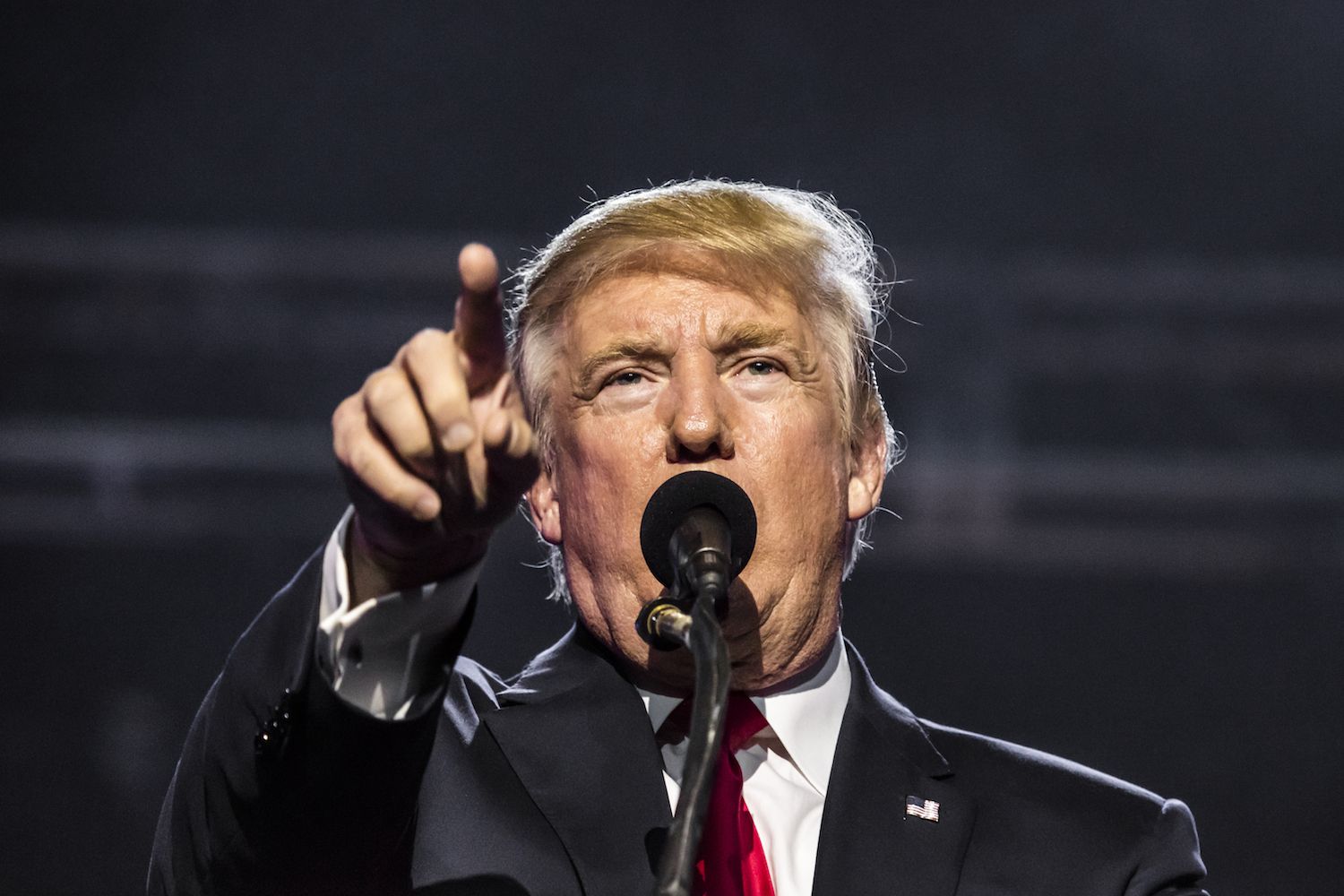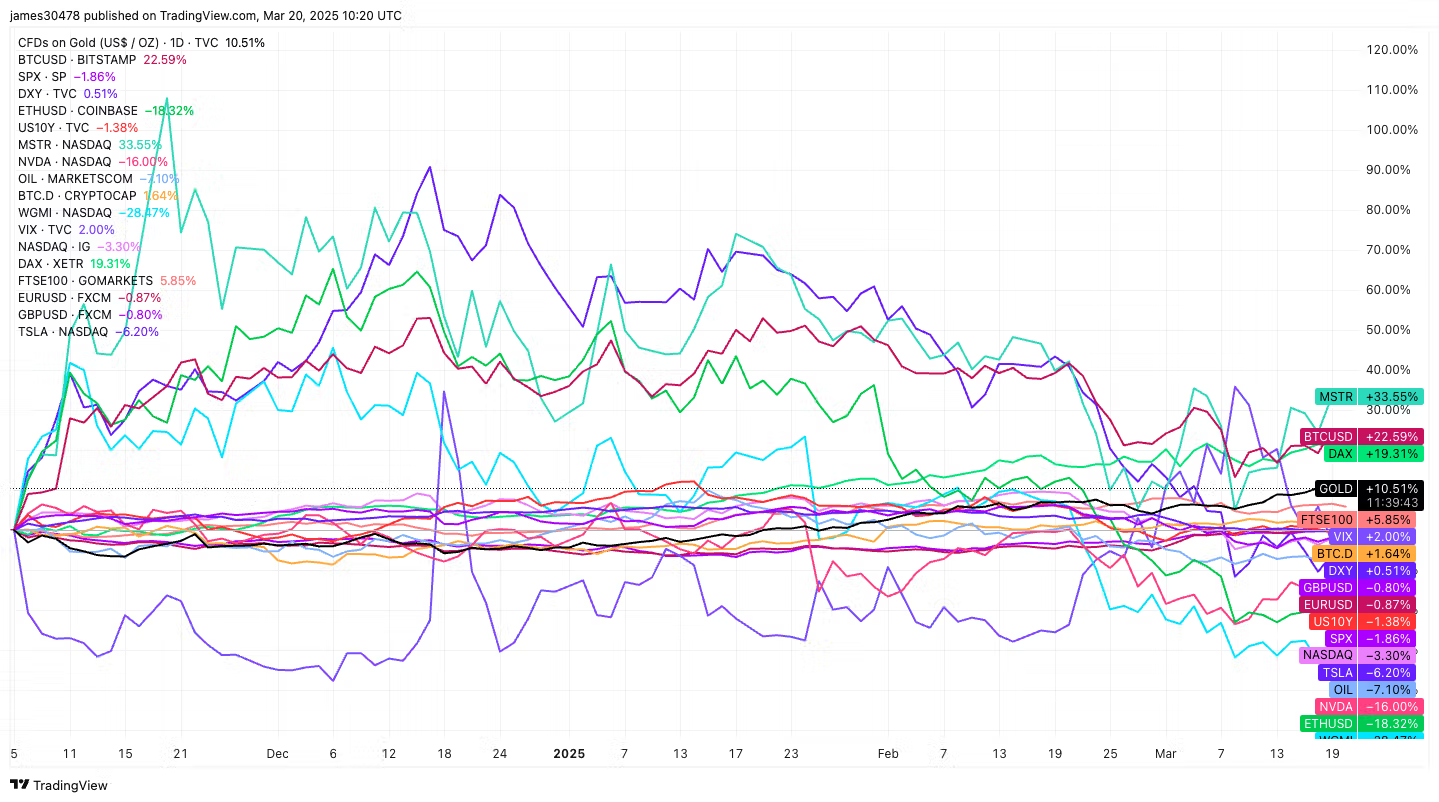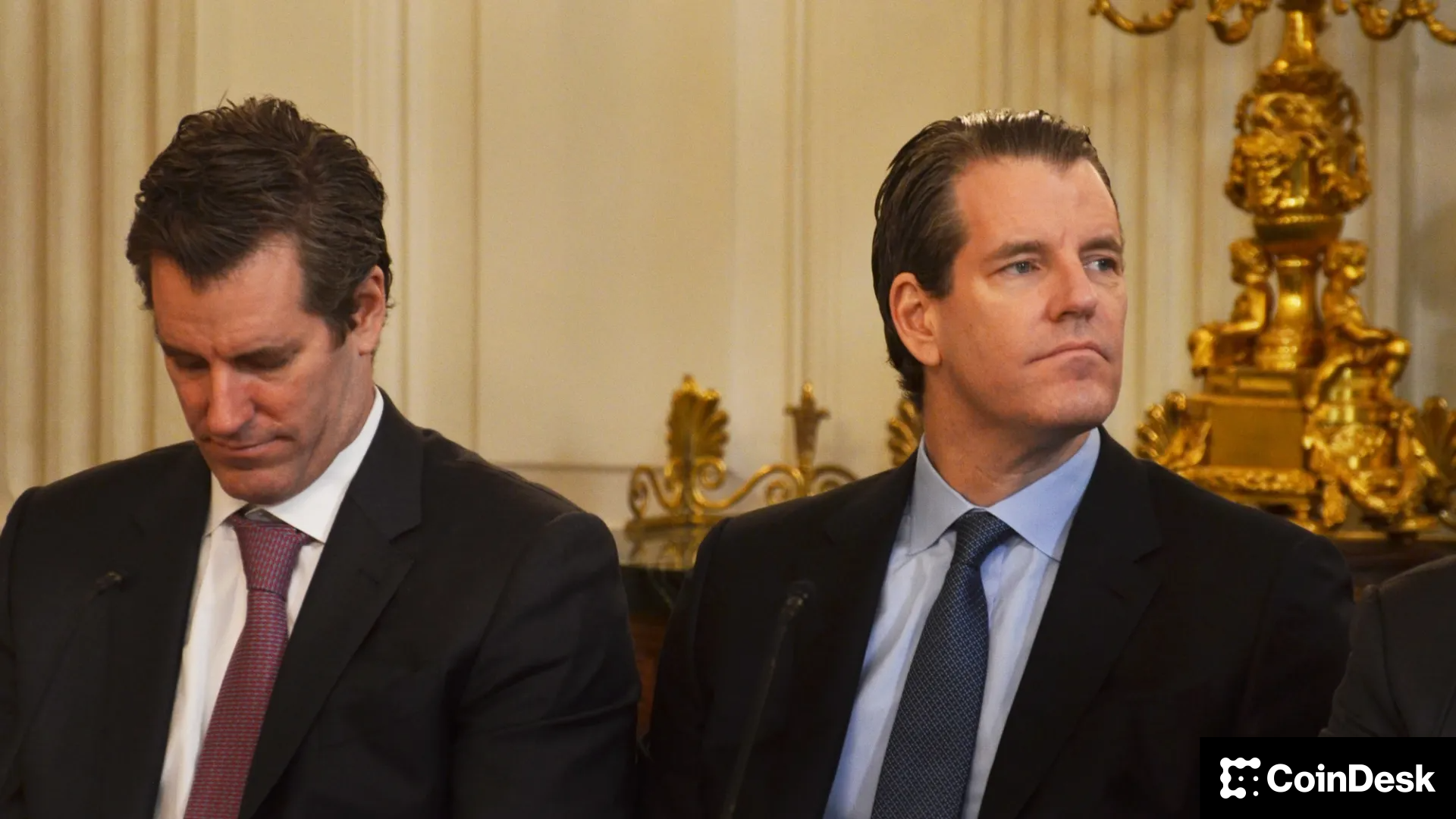Uncategorized
Gold Surges, Bitcoin Rallies, Stocks Down Since Trump’s Electoral Win — What’s Driving the Chaos?

Pro-crypto Donald Trump won the U.S. presidential election over four months ago, and since then, the period has been characterized by financial market turbulence and global uncertainties surrounding tariffs, geopolitical tensions, and ongoing conflicts in the Middle East and between Ukraine and Russia.
Bitcoin (BTC) has surged over 23% since the Nov. 5 election, reaching an all-time high of over $109K at the end of January. Despite a subsequent 30% decline from its peak, it remains one of the best-performing assets. Strategy (MSTR), often considered a bitcoin proxy, has gained 34%, recovering well under the Trump administration despite previously dropping around 60% from its November highs.
Ethereum’s ether token (ETH) has fallen by as much as 18%, alongside disappointing action in the broader crypto market. The Valkyrie Bitcoin Mining ETF has also struggled, dropping almost 30%. Meanwhile, investors have rotated money into BTC, pushing its dominance rate higher by 2% to over 61.
European equities have done well, outshining their U.S. counterparts. The German DAX index is up 20%, and the UK’s FTSE 100 has gained 6%, alongside weaker performances in the U.S. stock market, where the Nasdaq and S&P 500 are both down approximately 2%. A recent report from Bank of America highlights a record drop in U.S. stock allocations. Gold, benefiting from uncertainty, has continued to set new all-time highs, surpassing $3,030—an 11% increase.
The U.S. Dollar Index (DXY), which measures the dollar’s strength against a basket of major currencies, remains flat. However, under Trump, the dollar has weakened significantly, providing some relief to risk assets and major currencies such as the Euro and the Great British Pound.
Meanwhile, the U.S. 10-year Treasury yield has slightly declined to 4.2%, a key metric the administration is closely monitoring. Oil prices have plummeted by around 7% as the U.S. maintains its stance on energy dominance to reduce energy costs.
Notably, some of the so-called «Magnificent 7» stocks have struggled, with NVIDIA (NVDA) down 16% and Tesla (TSLA) declining 6%.
Detox underway?
Recent losses on Wall Street and in the crypto market have ignited hopes for the «Trump put,» or potential policy support. However, the administration appears willing to endure short-term pain for long-term benefits, believing that this approach will cleanse the markets of the fiscal spending excesses of the Biden era.
This reset is expected to be characterized lower inflation, improved energy security, and a lower 10-year Treasury yield.
«Scott Bessent’s talk of a “detox period” suggests a controlled downturn might be ahead. If that’s the case, Trump’s playbook seems clear: blame the recession on Biden, use tariffs and crypto narratives to manage costs, and push for lower interest rates to fuel tech and AI growth. Short-term pain, long-term gain—that’s the strategy,» Gracy Chen, CEO of Bitget, said in an email to CoinDesk this week.
«Regardless, I don’t see BTC falling below 70k, possibly 73-78k which is a solid time to enter for any buyers on the fence. In the next 1-2 years, BTC at 200k isn’t as far-fetched as most would think,» Chen added.

Business
Crypto Trading Firm Keyrock Buys Luxembourg’s Turing Capital in Asset Management Push

Crypto trading firm Keyrock said it’s expanding into asset and wealth management by acquiring Turing Capital, a Luxembourg-registered alternative investment fund manager.
The deal, announced on Tuesday, marks the launch of Keyrock’s Asset and Wealth Management division, a new business unit dedicated to institutional clients and private investors.
Keyrock, founded in Brussels, Belgium and best known for its work in market making, options and OTC trading, said it will fold Turing Capital’s investment strategies and Luxembourg fund management structure into its wider platform. The division will be led by Turing Capital co-founder Jorge Schnura, who joins Keyrock’s executive committee as president of the unit.
The company said the expansion will allow it to provide services across the full lifecycle of digital assets, from liquidity provision to long-term investment strategies. «In the near future, all assets will live onchain,» Schnura said, noting that the merger positions the group to capture opportunities as traditional financial products migrate to blockchain rails.
Keyrock has also applied for regulatory approval under the EU’s crypto framework MiCA through a filing with Liechtenstein’s financial regulator. If approved, the firm plans to offer portfolio management and advisory services, aiming to compete directly with traditional asset managers as well as crypto-native players.
«Today’s launch sets the stage for our longer-term ambition: bringing asset management on-chain in a way that truly meets institutional standards,» Keyrock CSO Juan David Mendieta said in a statement.
Read more: Stablecoin Payments Projected to Top $1T Annually by 2030, Market Maker Keyrock Says
Business
Crypto Trading Firm Keyrock Buys Luxembourg’s Turing Capital in Asset Management Push

Crypto trading firm Keyrock said it’s expanding into asset and wealth management by acquiring Turing Capital, a Luxembourg-registered alternative investment fund manager.
The deal, announced on Tuesday, marks the launch of Keyrock’s Asset and Wealth Management division, a new business unit dedicated to institutional clients and private investors.
Keyrock, founded in Brussels, Belgium and best known for its work in market making, options and OTC trading, said it will fold Turing Capital’s investment strategies and Luxembourg fund management structure into its wider platform. The division will be led by Turing Capital co-founder Jorge Schnura, who joins Keyrock’s executive committee as president of the unit.
The company said the expansion will allow it to provide services across the full lifecycle of digital assets, from liquidity provision to long-term investment strategies. «In the near future, all assets will live onchain,» Schnura said, noting that the merger positions the group to capture opportunities as traditional financial products migrate to blockchain rails.
Keyrock has also applied for regulatory approval under the EU’s crypto framework MiCA through a filing with Liechtenstein’s financial regulator. If approved, the firm plans to offer portfolio management and advisory services, aiming to compete directly with traditional asset managers as well as crypto-native players.
«Today’s launch sets the stage for our longer-term ambition: bringing asset management on-chain in a way that truly meets institutional standards,» Keyrock CSO Juan David Mendieta said in a statement.
Read more: Stablecoin Payments Projected to Top $1T Annually by 2030, Market Maker Keyrock Says
Business
Gemini Shares Slide 6%, Extending Post-IPO Slump to 24%

Gemini Space Station (GEMI), the crypto exchange founded by Cameron and Tyler Winklevoss, has seen its shares tumble by more than 20% since listing on the Nasdaq last Friday.
The stock is down around 6% on Tuesday, trading at $30.42, and has dropped nearly 24% over the past week. The sharp decline follows an initial surge after the company raised $425 million in its IPO, pricing shares at $28 and valuing the firm at $3.3 billion before trading began.
On its first day, GEMI spiked to $45.89 before closing at $32 — a 14% premium to its offer price. But since hitting that high, shares have plunged more than 34%, erasing most of the early enthusiasm from public market investors.
The broader crypto equity market has remained more stable. Coinbase (COIN), the largest U.S. crypto exchange, is flat over the past week. Robinhood (HOOD), which derives part of its revenue from crypto, is down 3%. Token issuer Circle (CRCL), on the other hand, is up 13% over the same period.
Part of the pressure on Gemini’s stock may stem from its financials. The company posted a $283 million net loss in the first half of 2025, following a $159 million loss in all of 2024. Despite raising fresh capital, the numbers suggest the business is still far from turning a profit.
Compass Point analyst Ed Engel noted that GEMI is currently trading at 26 times its annualized first-half revenue. That multiple — often used to gauge whether a stock is expensive — means investors are paying 26 dollars for every dollar the company is expected to generate in sales this year. For a loss-making company in a volatile sector, that’s a steep price, and could be fueling investor skepticism.
-

 Business11 месяцев ago
Business11 месяцев ago3 Ways to make your business presentation more relatable
-

 Fashion11 месяцев ago
Fashion11 месяцев agoAccording to Dior Couture, this taboo fashion accessory is back
-

 Entertainment11 месяцев ago
Entertainment11 месяцев ago10 Artists who retired from music and made a comeback
-

 Entertainment11 месяцев ago
Entertainment11 месяцев ago\’Better Call Saul\’ has been renewed for a fourth season
-

 Entertainment11 месяцев ago
Entertainment11 месяцев agoNew Season 8 Walking Dead trailer flashes forward in time
-

 Business11 месяцев ago
Business11 месяцев ago15 Habits that could be hurting your business relationships
-

 Entertainment11 месяцев ago
Entertainment11 месяцев agoMeet Superman\’s grandfather in new trailer for Krypton
-

 Entertainment11 месяцев ago
Entertainment11 месяцев agoDisney\’s live-action Aladdin finally finds its stars




